Understanding Watts, Amps, and Volts in the LED World
Does this situation look familiar?
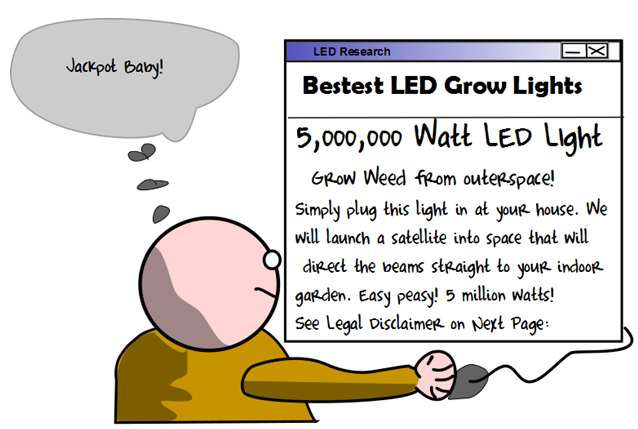
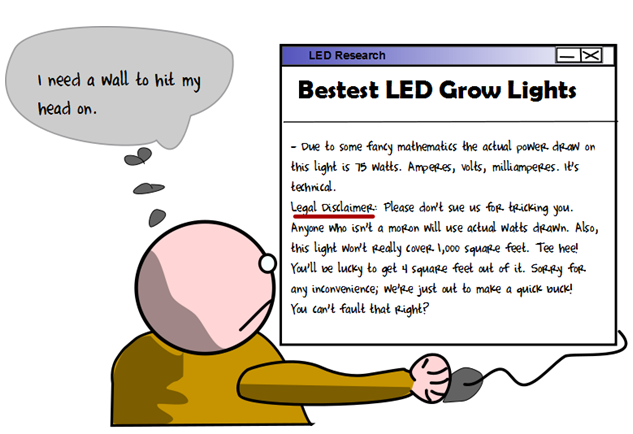
Why Watts are Important
Watts are important when buying an LED grow light because they help you determine how powerful the light is and how much area the light will cover. For example a 180 watt light will be more powerful and cover more area than a 90 watt light. Makes sense right?
Well, unfortunately life isn’t that simple. A light that is labeled a 180 watt light might actually only be drawing (sucking power from your wall at a rate of) 120 watts. On the flip side, a light that is labeled 120 watts might actually be drawing 180 watts. This watt-labeling debacle has led many people down a path of cusswords and inhumane thoughts of torturing LED grow light companies and LED diode manufacturers.
In the following sections, I’ll explain how this watt-labeling problem began. If you seek enlightenment on the subject of watt labeling in the LED world then read this whole post. If you’d rather not know all the technical stuff, just read the section entitled Important Stuff.
Important Stuff
There are really two key takeaways from the watt discussion:
(1). An LED light that is labeled with a certain amount of watts doesn’t actually draw that many watts. For example an LED grow light labeled at 350 watts does not actually draw 350 watts!
(2). You need to look at actual watts drawn when determining how much area an LED grow light will cover. You can find this information in two ways: (1) Pray that the owners list the actual draw on their website—more and more owners are doing this—or (2) contact them and ask. You can also look at my LED grow light reviews (I always contact the owners and find out how many watts each of their lights are actually pulling).
Technical Stuff/ Less Important, but Enlightening
Anyone who understands the LED grow light industry realizes that there is a difference between the watts stated by the LED companies and the actual amount of watts you’ll be getting. This is frustrating and leads to confusion and coverage area problems.
Are LED Grow Light Companies Just Lying to Us?
If a 180 watt light only actually draws 120 watts aren’t LED grow companies scamming us? Well, the truth is most of them aren’t intentionally scamming you. To figure out where this problem is coming from we must start at the beginning with some background information:
Background Information
Watts = Amperes X Volts Watts, amperes, and volts are all units of power.
There are three parties at play here:
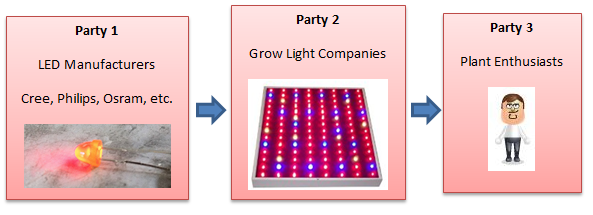
Here’s how it all works:
LED manufacturers (e.g. Cree, Philips, Osram) build individual diodes that look more or less like this:
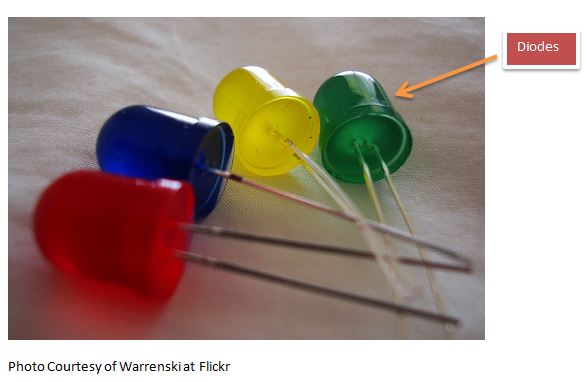
Each of these individual diodes is built to vary in the amount of amperes and volts they can handle (remember that volts and amperes are just units of power; don’t get overwhelmed by this my friend). One diode may be designed to handle .35 amperes, and another might be made to handle .7 amperes. In addition some diodes are built to handle 2.25 volts, others 3.4 volts, etc.
Consumers like us want to know how many watts of power we are getting (we don’t want to hear about amperes and volts). It is the job of the manufacturers of the diodes ( Party 1: Cree, Philips, Osram) to decide how many watts each diode is. This is an important distinction. It is not the LED grow light company that labels the wattage on these diodes; it is the diode manufacturers.
The scientists making these individual diodes got together, threw back some Heineken, and decided that 350 milliamperes (there are 1,000 milliamperes in one ampere) equaled 1 watt. Don’t question why they did it; they were having a good time and 350 was the magic number.

For some scientific reasons red diodes are designed to take in around 2.25 volts each and the blue ones are designed to take in about 3.4 volts each.
Let’s Perform Some Quick Calculations:
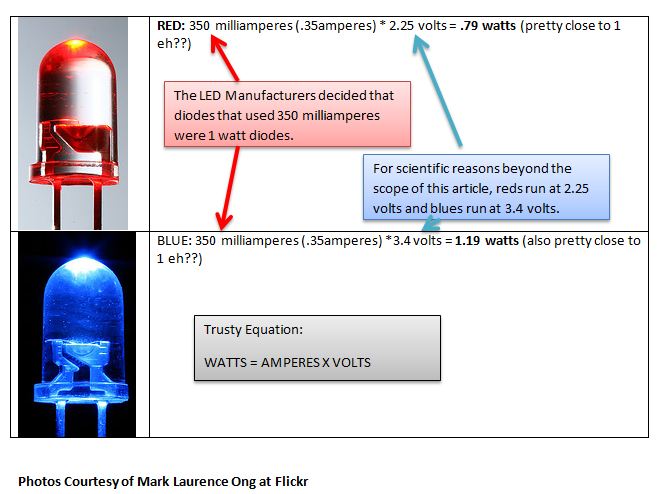
Okay, so after all this nonsense you can probably see that it was more than just the Heinekens talking when they chose 350 milliamperes to represent a 1 watt light. It appears to be some sort of average of the different colors of diodes (blues at 1.2 watts and reds at .8 watts). Yes, I also find it weird that each diode runs at a different volt amount.
Ok, let’s recap. The scientists who create the individual diodes got together and decided that any of their diodes that handled exactly 350 milliamperes were 1 watt diodes. We have seen that this is a bit of a rough estimate (red 1-watt diodes are closer to .8 watts and blue 1-watt diodes are closer to 1.2 watts).
Now, the LED grow light companies (party 2 from above) enter the scene. The LED grow light companies purchase these diodes from the manufacturers and put them together on a motherboard. There are usually around 50 to 200 diodes on each of these motherboards.
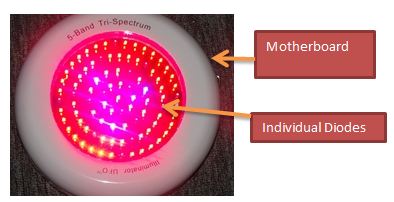
The light you see above is labeled a 90 watt light. It is labeled at 90 watts because the company that makes this light bought ninety “1-watt” diodes from a manufacturer of diodes and put those 90 diodes on a motherboard.
However, remember from our discussion above that each “1-watt” diode doesn’t actually give you 1-watt of power.
Let’s assume (and I’m just throwing out numbers here) that the grow light above has 70 red diodes and 20 blue diodes. Let’s calculate the actual watts drawn using our numbers from above.
70 RED * .8watts (.8 is the number we calculated above for a 1-watt red diode) = 56 watts
20 Blue * 1.2watts (1.2 is the number we calculated above for a 1-watt blue diode)= 24 watts
Actual watts drawn = 80 watts.
What’s a measly 10 watts right? Well, the truth is 10 watts doesn’t make a huge deal. This example shows that 1-watt diodes are fairly efficient (efficient in the sense that they actually draw close to 1-watt). Let’s look at another example though using 3-watt diodes.
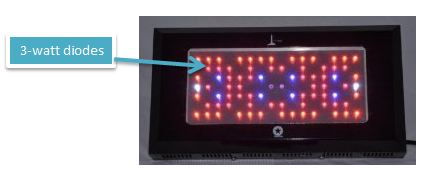
The light above is labeled a 240 watt light because the LED grow light company purchased 80 three-watt diodes to make this light (80*3=240).
Before this grow light was created, the manufacturers of the diodes (Cree, Osram, Philips) got together again, drank some more beer, and decided that all diodes that run at 700 milliamperes are 3-watt diodes. Let’s do the math using our trusty equation:
Amperes X Volts = Actual Watts
RED 3-Watts = 700 milliamperes (.7amperes) X 2.25 volts = 1.575 watts!! It wasn’t a big deal going from 1 watt to .8 watts, but now someone who thinks they are getting 3 watts of pure growing love is actually only getting 1.6 per red diode.
Blue 3-Watts = 700 milliamperes (.7amperes) X 3.4 = 2.38 watts!! Even the blues don’t get above 3 watts. The manufacturers must have been completely plastered when they came up with 700 milliamperes = 3 watts.
Let’s go back to our 240 watt light example above. Remember that there are 80 three-watt diodes in this light. Let’s assume 60 red and 20 blue.
60 Red X 1.575 watts = 94.5 watts
20 Blue X 2.38 watts = 47.6 watts
Actual Watts Drawn = 142.1 watts
At this point the unknowing consumer comes along (party 3 mentioned above). He buys a 240 watt LED grow light thinking it has 240 watts of pure growing love when in fact it only draws 142 watts. He then makes bad decisions about coverage area and how many plants he can grow under the light.
Who is at Fault?
There is plenty of blame to go around here. I personally wish that the manufacturers would come up with better estimates for their 3-watt diodes. However, the easiest solution is for the LED grow light companies to start labeling their lights based on the actual amount of watts drawn. At the very least, they should be offering this information freely. Most of the companies do offer the actual watts drawn. If they don’t, then I recommend you stay away from them or call and ask them for it.
Conclusion
This turned out to be a mammoth post. Things got more technical than I would have liked. Remember that LED grow lights are labeled a bit deceivingly in terms of watts (this is not the grow light companies’ fault). At the end of the day the lesson is look for the actual amount of watts drawn and not the amount that is labeled.


This is some seriously important information and totally stopped me from making some very misinformed purchasing decisions, thank you so much for spelling it all out for me.
Hey Mike,
Glad I could help. More than a few people have purchased an LED light thinking they were getting something a lot more powerful than they were.
Nate
hi,
nice post and site. i am wondering though, what does watts tell about lumens or PAR. aren’t those important things to consider in a light?
i’m just now trying to assimilate all this info.
curious,
thanks
ben
Hey Ben,
Yeah PAR is one of the most important things to consider in my view. Watts don’t specifically tell us how much PAR a light has. However, in general, the more watts an LED is drawing, the higher the PAR output of the light will be. This is just a rule of thumb obviously.
Best,
Nate